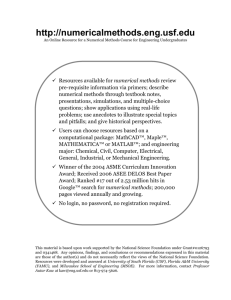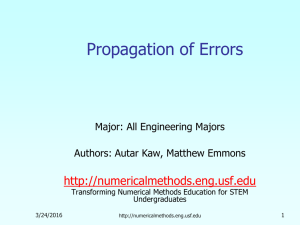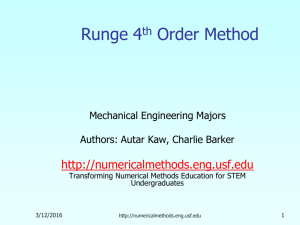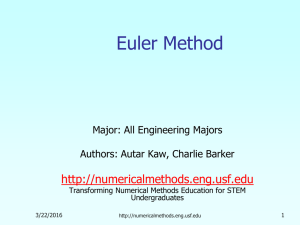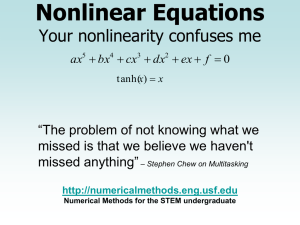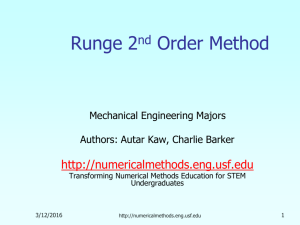Document
advertisement
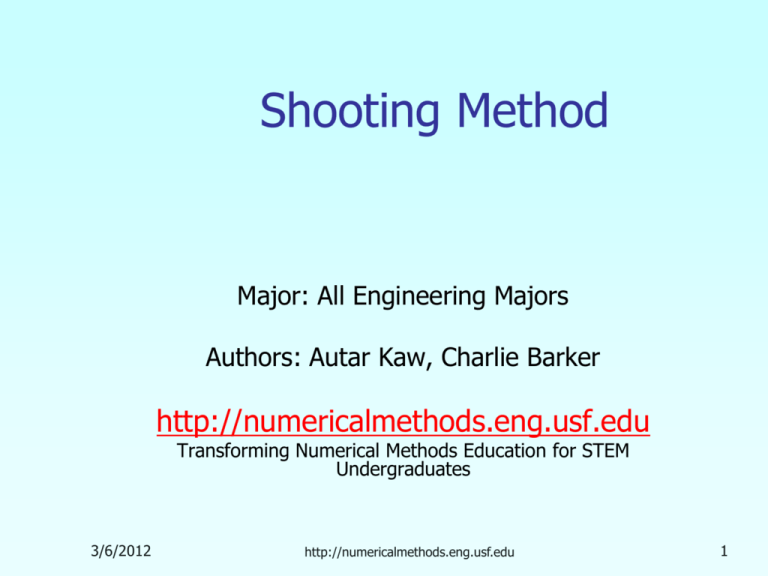
Shooting Method Major: All Engineering Majors Authors: Autar Kaw, Charlie Barker http://numericalmethods.eng.usf.edu Transforming Numerical Methods Education for STEM Undergraduates 3/6/2012 http://numericalmethods.eng.usf.edu 1 Shooting Method http://numericalmethods.eng.usf.edu Shooting Method The shooting method uses the methods used in solving initial value problems. This is done by assuming initial values that would have been given if the ordinary differential equation were a initial value problem. The boundary value obtained is compared with the actual boundary value. Using trial and error or some scientific approach, one tries to get as close to the boundary value as possible. 3 http://numericalmethods.eng.usf.edu Example d 2u 1 du u + − 2 = 0, 2 dr r dr r u (5) = 0.0038731, u (8) = 0.0030770 r a b Let du =w dr Then Where and a=5 b=8 dw 1 u + w− 2 =0 dr r r 4 http://numericalmethods.eng.usf.edu Solution Two first order differential equations are given as du = w, u (5) = 0.0038371 dr dw w u = − + 2 , w(5) = not known dr r r Let us assume w(5) = du (5) ≈ u (8) − u (5) = −0.00026538 dr 8−5 To set up initial value problem du = w = f1 (r , u , w), u (5) = 0.0038371 dr dw w u = − + 2 = f 2 (r , u , w), w(5) = −0.00026538 dr r r 5 http://numericalmethods.eng.usf.edu Solution Cont Using Euler’s method, ui +1 = ui + f1 (ri , ui , wi )h wi +1 = wi + f 2 (ri , ui , wi )h Let us consider 4 segments between the two boundaries, r = 5 and r = 8 then, 8−5 h= = 0.75 4 6 http://numericalmethods.eng.usf.edu Solution Cont For i = 0, r0 = 5, u0 = 0.0038371, w0 = −0.00026538 u1 = u0 + f1 (r0 , u0 , w0 )h = 0.0038371 + f1 (5,0.0038371,−0.00026538)(0.75) = 0.0038371 + (− 0.00026538)(0.75) = 0.0036741 w1 = w0 + f 2 (r0 , u0 , w0 )h = −0.00026538 + f 2 (5,0.0038371,−0.00026538)(0.75) − 0.00026538 0.0038371 = −0.00026538 + − + (0.75) 2 5 5 = −0.00010938 7 http://numericalmethods.eng.usf.edu Solution Cont For i = 1, r1 = r0 + h = 5 + 0.75 = 5.75, u1 = 0.0036741, w1 = −0.00010940 u2 = u1 + f1 (r1 , u1 , w1 )h = 0.0036741 + f1 (5.75,0.0036741,−0.00010938)(0.75) = 0.0036741 + (− 0.00010938)(0.75) = 0.0035920 w2 = w1 + f 2 (r1 , u1 , w1 )h = −0.00010938 + f 2 (5.75,0.0036741,−0.00010938)(0.75) = −0.00010938 + (0.00013015)(0.75) = −0.000011769 8 http://numericalmethods.eng.usf.edu Solution Cont For i = 2, r2 = r1 + h = 5.75 + 0.75 = 6.5 u2 = 0.0035920, w2 = −0.000011785 u3 = u2 + f1 (r2 , u2 , w2 )h = 0.0035920 + f1 (6.5,0.0035920,−0.000011769)(0.75) = 0.0035920 + (− 0.000011769)(0.75) = 0.0035832 w3 = w2 + f 2 (r2 , u2 , w2 )h = −0.000011769 + f 2 (6.5,0.0035920,−0.000011769)(0.75) = −0.000011769 + (0.000086829)(0.75) = 0.000053352 9 http://numericalmethods.eng.usf.edu Solution Cont For i = 3, r3 = r2 + h = 6.50 + 0.75 = 7.25 u3 = 0.0035832, w3 = 0.000053332 u4 = u3 + f1 (r3 , u3 , w3 )h = 0.0035832 + f1 (7.25,0.0035832,0.000053352)(0.75) = 0.0035832 + (0.000053352)(0.75) = 0.0036232 w4 = w3 + f 2 (r3 , u3 , w3 )h = −0.000011785 + f 2 (5.75,0.0035832,−0.000053352)(0.75) = 0.000053352 + (0.000060811)(0.75) = 0.000098961 So at r = r4 = r3 + h = 7.25 + 0.75 = 8 u (8) ≈ u4 = 0.0036232 10 http://numericalmethods.eng.usf.edu Solution Cont Let us assume a new value for w(5) = 2 du (5) dr du (5) ≈ 2 u (8) − u (5) = 2(− 0.00026538) = −0.00053076 8−5 dr Using h = 0.75 and Euler’s method, we get u (8) ≈ u4 = 0.0029665" While the given value of this boundary condition is u (8) ≈ u4 = 0.0030770 11 http://numericalmethods.eng.usf.edu Solution Cont Using linear interpolation on the obtained data for the two assumed values of du (5) dr we get u (8) = 0.00030770 du (5) ≈ − 0.00053076 − (− 0.00026538) (0.0030770 − 0.0036232) + (− 0.00026538) dr 0.0029645 − 0.0036232 = −0.00048611 Using h = 0.75 and repeating the Euler’s method with w(5) = −0.00048611 u (8) ≈ u4 = 0.0030769 12 http://numericalmethods.eng.usf.edu Solution Cont Using linear interpolation to refine the value of u4 till one gets close to the actual value of u (8) which gives you, u0 = u (5) = 0.0038731 u (5.75) ≈ u1 = 0.0035085 u (6.50 ) ≈ u2 = 0.0032858 u (7.25) ≈ u3 = 0.0031518 u (8.00 ) ≈ u4 = 0.0030770 13 http://numericalmethods.eng.usf.edu Comparisons of different initial guesses 4.0E-03 du/dr = -0.00026538 Radial Displacement, u (in) 3.8E-03 3.6E-03 Exact 3.4E-03 du/d r= -0.00048611 3.2E-03 du/dr = -0.00053076 3.0E-03 5 6 7 8 Radial Location, r (in) 14 http://numericalmethods.eng.usf.edu Comparison of Euler and RungeKutta Results with exact results Table 1 Comparison of Euler and Runge-Kutta results with exact results. 15 r (in) Exact (in) 5 5.75 6.5 7.25 8 3.8731×10−3 3.5567×10−3 3.3366×10−3 3.1829×10−3 3.0770×10−3 Euler (in) ∈t % 3.8731×10−3 0.0000 3.5085×10−3 1.3731 1.5482 3.2858×10−3 3.1518×10−3 9.8967×10−1 3.0770×10−3 1.9500×10−3 Runge-Kutta (in) ∈t % 3.8731×10−3 3.5554×10−3 3.3341×10−3 3.1792×10−3 3.0723×10−3 0.0000 3.5824×10−2 7.4037×10−2 1.1612×10−1 1.5168×10−1 http://numericalmethods.eng.usf.edu Additional Resources For all resources on this topic such as digital audiovisual lectures, primers, textbook chapters, multiple-choice tests, worksheets in MATLAB, MATHEMATICA, MathCad and MAPLE, blogs, related physical problems, please visit http://numericalmethods.eng.usf.edu/topics/shooting_ method.html THE END http://numericalmethods.eng.usf.edu

